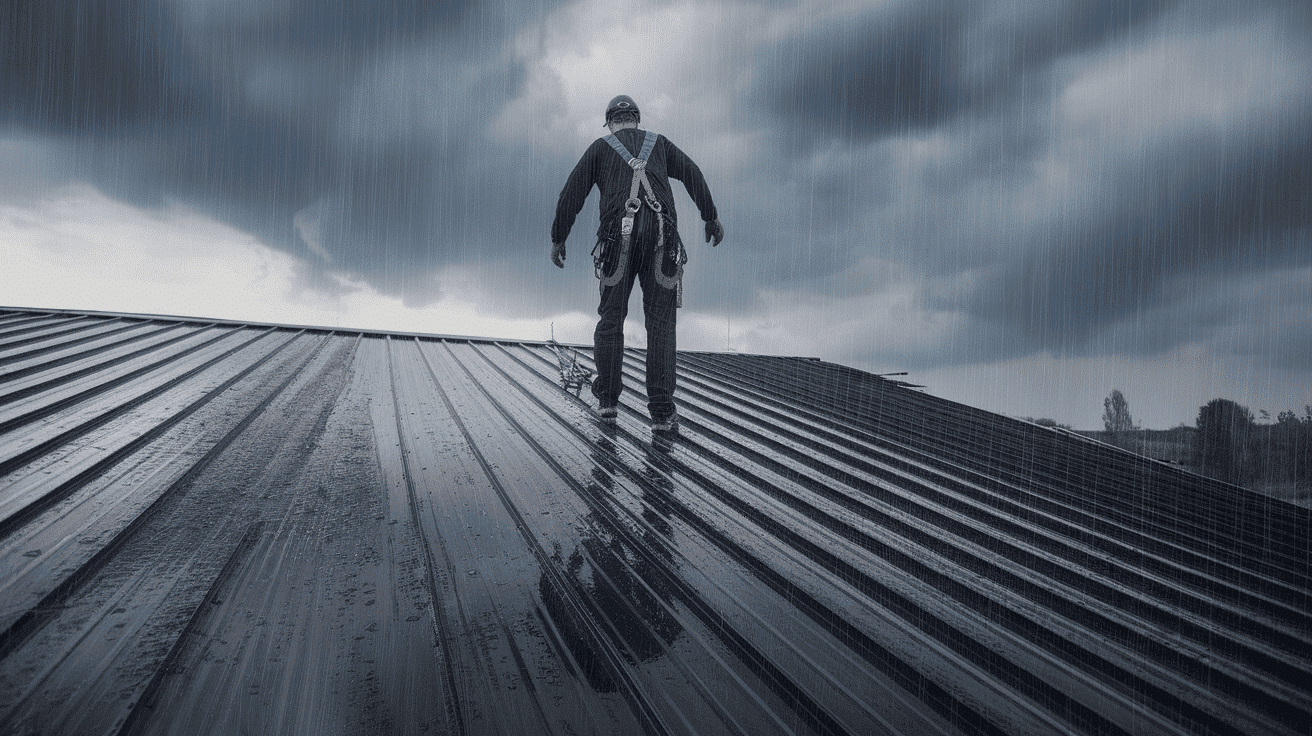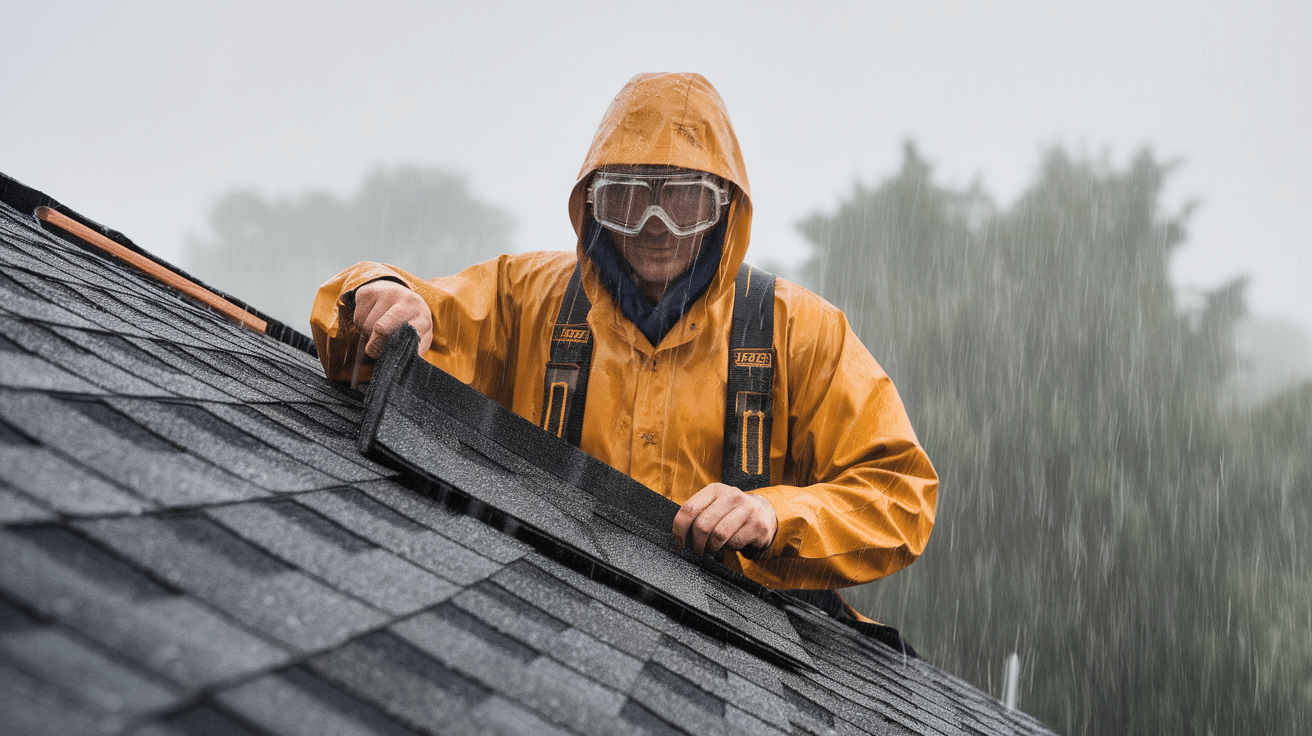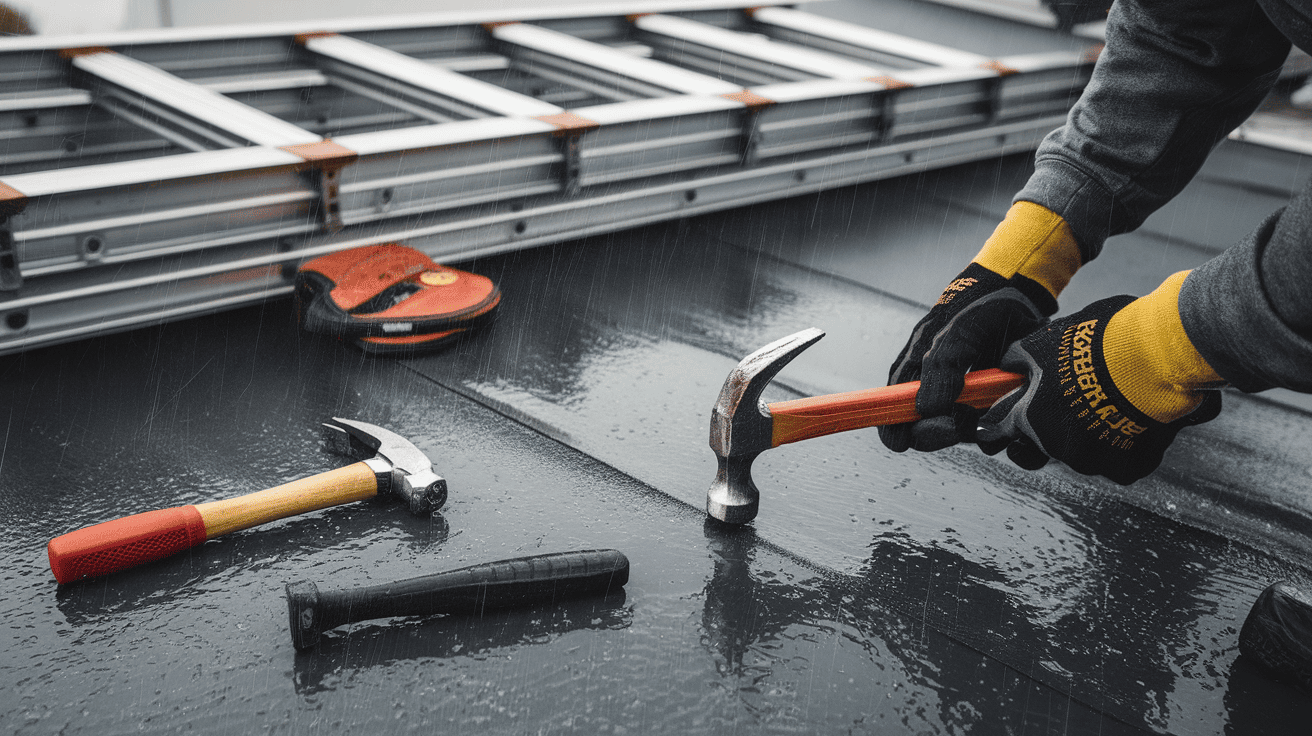Picture this: You’ve scheduled a major roof replacement, taken time off work, and coordinated everything perfectly. Then the weather forecast changes overnight, showing three days of steady rain right when your project is supposed to start. Should you push forward or wait it out?
Roofing in the rain poses serious safety risks, material damage, and costly complications that many homeowners are not fully aware of. While emergency repairs sometimes can’t wait, planned installations should almost never proceed in wet conditions.
This guide will break down the real dangers of wet weather roofing, explain how moisture damages materials, cover insurance implications, and give you professional strategies for handling weather delays safely and effectively.
Why Roofing in the Rain is Risky Business?
Working on roofs during wet weather creates serious safety concerns that no homeowner or contractor should ignore. Roofing in the rain turns what’s already a challenging job into a dangerous situation that puts both workers and your property at risk.
1. Slippery Surfaces Create Major Fall Hazards

Rain makes every surface on your roof extremely slippery. Metal roofing becomes like an ice rink when wet. Asphalt shingles lose their grip. Even flat roofs can become slick surfaces, causing workers to lose their footing in seconds.
Professional roofers know the statistics are scary. Falls from roofs account for thousands of injuries each year, and wet conditions significantly increase the likelihood of these accidents. The dangers of roofing in the rain become even more serious when safety equipment, such as harnesses and ropes, also becomes slippery and less reliable.
2. Poor Visibility Makes Every Task Harder

Heavy rain reduces visibility, making it difficult to see potential problems or hazards. Workers can’t spot loose materials, damaged areas, or other safety concerns when rain is pelting their faces.
This reduced visibility also affects precision work. Installing shingles requires careful alignment and proper placement. When you can’t see clearly, mistakes occur more frequently, which can lead to leaks or structural issues.
3. Tools and Equipment Stop Working Properly

Roofing safety in the rain gets compromised when tools malfunction. Nail guns can jam when moisture gets inside. Power tools may short-circuit. Hand tools become slippery and harder to grip securely.
Ladders become particularly hazardous in wet conditions. Many roofing accidents happen when workers are climbing up or down, not while they’re actually on the roof.
The Hidden Damages on Roofing Materials
Different roofing materials and moisture don’t mix well, creating problems that can last for years after installation. Understanding these issues helps explain why professional contractors refuse to work in wet conditions.
1. Wood Materials Suffer the Most
Wet roof decks are susceptible to swelling, warping, and eventual rot. Wood decking that gets soaked during installation never properly dries out once covered with underlayment and shingles. This trapped moisture leads to mold growth and structural weakening over time.
Wooden shakes absorb water like sponges, expanding and creating gaps when they eventually dry. These gaps allow water infiltration, defeating the purpose of having a roof.
2. Asphalt Shingles Won’t Adhere Properly
Asphalt shingles rely on heat-activated adhesive strips to seal properly. When surfaces are wet, these strips can’t bond correctly, leaving your roof vulnerable to wind damage and water infiltration.
Installing shingles over wet underlayment also prevents proper adhesion and can cause buckling or rippling as materials dry at different rates.
3. Metal Roofing Installation Problems
While metal doesn’t absorb water like wood, roofing in the rain still creates installation problems. Screws and fasteners won’t seal properly when driven into wet surfaces. Water can get trapped under seams, leading to corrosion and leaks.
Quick Fixes for Rainy Roof Repairs
Sometimes you can’t wait for perfect weather, especially when dealing with active leaks that threaten your home’s interior. Professional contractors have specific protocols for these emergencies.
1. Emergency Repairs vs. New Installations
- Emergency repairs – Focus on stopping immediate water damage from active leaks.
- New installations – Require optimal dry conditions for long-term performance.
- Know the difference to make smart decisions about timing.
2. Temporary Roof Protection During Rain
- Use heavy-duty tarps or synthetic underlayment to cover exposed areas.
- Professional contractors keep these materials on every job site for unexpected weather.
- Secure tarps tightly without allowing wind to catch underneath.
- Ensure proper water runoff to prevent pooling or additional leak points.
3. The “Dry-In” Process
- Install underlayment over the entire roof deck before the expected weather.
- Protects the deck from moisture even when shingles can’t be installed.
- Everything must dry completely before continuing with permanent installation.
- Provides temporary protection while waiting for better conditions.
Key Point: Emergency measures prioritize damage control over long-term solutions. Save quality installation work for dry weather.
Legal Implications of Wet Weather Roofing
Working in unsafe weather conditions can create serious legal and financial consequences that extend far beyond your immediate roofing project. These risks can impact your finances, property, and legal standing.
Your roofing materials come with manufacturer warranties that protect your investment. However, these warranties become worthless if contractors don’t follow proper installation guidelines. Most manufacturers require dry conditions for installation, and failing to meet this requirement voids your warranty coverage.
1. Key warranty risks include:
- Loss of material warranty protection
- No coverage for premature failure
- Expensive out-of-pocket replacement costs
- Reduced property value from substandard work
The Occupational Safety and Health Administration (OSHA) has strict guidelines about working in wet conditions. These aren’t suggestions – they’re legal requirements that carry real consequences.
2. OSHA violation consequences:
- Heavy fines for non-compliance
- Work stoppage orders
- Legal liability for safety violations
- Potential criminal charges in severe cases
Your homeowner’s insurance policy requires you to take reasonable steps to prevent accidents on your property. If a contractor gets injured due to unsafe weather conditions you allowed, you could face serious liability claims.
3. Insurance and liability risks:
- Personal injury lawsuits
- Workers’ compensation claims
- Homeowner’s insurance rate increases
- Potential policy cancellation
Insurance companies expect property owners to protect partially completed work from weather damage. This means working with your contractor to cover exposed areas with tarps during storms or rain events.
4. Property protection requirements:
- Cover exposed roof areas during weather events
- Document protective measures taken
- Work with contractors on weather response plans
- Maintain protection until work is complete
Failing to meet these requirements can result in denied water damage claims, leaving you to pay for repairs that could have been covered by insurance.
What Pro Roofers Do When Rain Hits a Job Site?
Experienced contractors have clear protocols when the weather turns bad. The moment rain starts, professional crews immediately stop work and secure the job site. Tools get covered or moved to dry locations. Any exposed decking gets protected with tarps or synthetic underlayment.
Smart contractors build weather delays into their project timelines and never promise completion dates without accounting for potential rain.
Contractors in rainy areas, such as Seattle, stock extra tarps, use moisture-resistant materials, and plan shorter work windows to minimize disruptions. These specialists understand that patient, careful work produces better results than rushing through poor conditions.
When to Reschedule and When to Proceed?
Knowing when to pause your roofing project versus when to push forward requires understanding the difference between urgent repairs and planned installations. Let’s know how to make the right decision for your situation.
- Always reschedule planned Installations when rain is forecast within 24-48 hours. New roof installations need completely dry conditions for materials to bond properly and prevent long-term problems. Even a drizzle can compromise shingle adhesion and create warranty issues.
- Proceed with caution: Only for emergency repairs when water is actively entering your home and causing damage. In these cases, focus on temporary fixes, such as tarping or patching, to stop immediate water intrusion. Save permanent repairs for dry weather.
- Check the extended forecast: If you see a brief shower followed by several dry days, it might be worth waiting. However, if you’re looking at a week of steady rain and have an active leak, emergency measures become necessary.
- Choose a good contractor: they will clearly explain why they recommend rescheduling and provide realistic timelines based on weather patterns. They should also have backup plans ready and help you understand the risks of proceeding in poor conditions.
Remember: A few extra days of waiting often prevents months of problems later.
Conclusion
Roofing in the rain presents serious safety risks, material damage concerns, and potential insurance complications, making it a poor choice for planned installations. While emergency repairs sometimes can’t wait, new roof projects should proceed only in dry conditions.
The smart approach involves working with experienced, insured contractors who understand weather-related risks and have proper protocols for protecting your property during delays. Quality roofing work requires patience, but the long-term results justify waiting for appropriate conditions.
Don’t let schedule pressure or contractor inexperience put your home and family at risk. Professional roofers refuse wet-weather installations because they understand the consequences.
Ready to discuss your roofing project? Schedule a consultation with certified professionals. Your roof protects everything you value most – make sure it’s installed right the first time.

